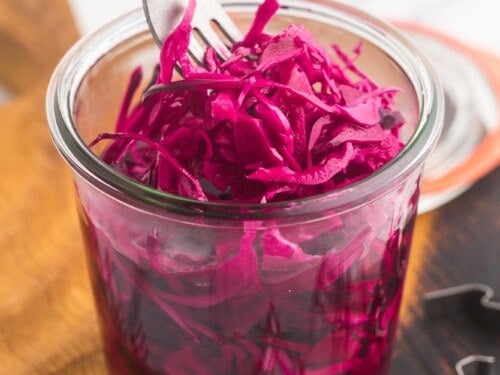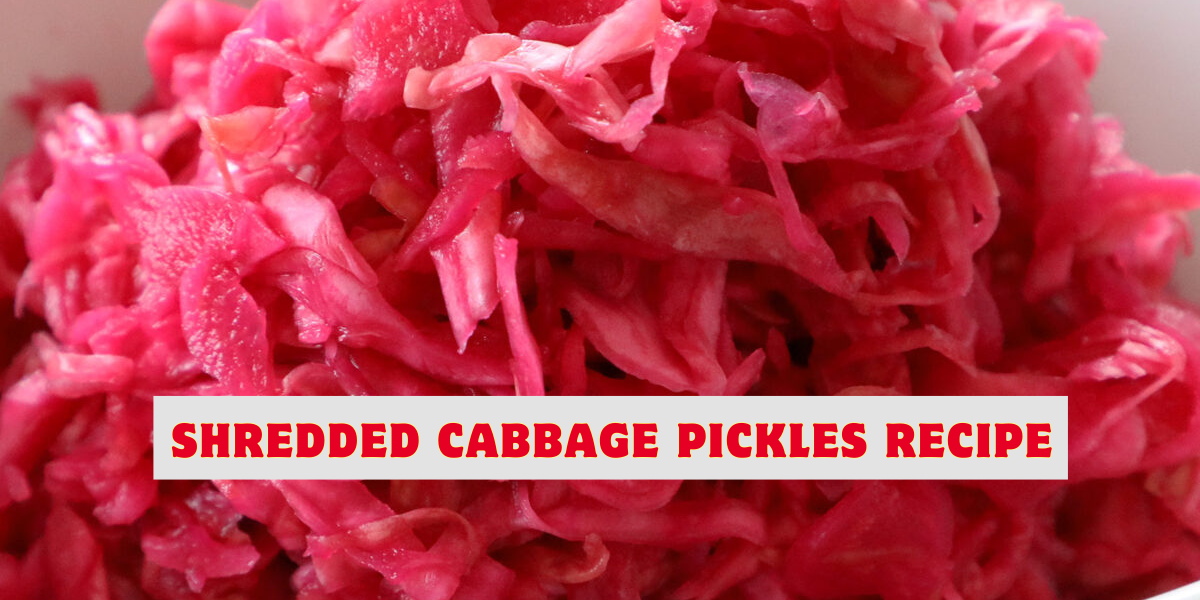Introduction
Shredded cabbage pickles are a delightful addition to any meal, offering a tangy crunch that complements a variety of dishes. Pickling cabbage is a fantastic way to preserve its fresh, crisp texture while infusing it with bold flavors. This article will explore the history and benefits of pickled cabbage, provide a detailed recipe for making it at home, and suggest creative ways to enjoy these versatile pickles.
History of Pickling
Pickling is an ancient preservation method that dates back thousands of years. Originating in Mesopotamia around 2400 BCE, pickling was used to extend the shelf life of vegetables and fruits. The process involves immersing food in an acidic solution, typically vinegar, or fermenting it in a salty brine. Over time, pickling became a staple in various cultures worldwide, each developing unique recipes and techniques. Cabbage, in particular, has been a popular choice for pickling due to its availability, affordability, and adaptability.
Cultural Significance
- Korea: In Korean cuisine, kimchi, a fermented cabbage dish, is a staple that showcases the country’s rich pickling tradition.
- Germany: Sauerkraut, a type of fermented cabbage, is a well-known German delicacy.
- Eastern Europe: Pickled cabbage is a common ingredient in many Eastern European dishes, often served as a side dish or in salads.

Health Benefits of Pickled Cabbage
Pickled cabbage is not only delicious but also packed with health benefits. The fermentation or pickling process enhances the nutritional profile of cabbage, making it a valuable addition to a balanced diet.
Nutritional Advantages
- Probiotics: Fermented cabbage, like sauerkraut and kimchi, is rich in probiotics, beneficial bacteria that promote gut health and improve digestion.
- Vitamins and Minerals: Cabbage is an excellent source of vitamins C and K, as well as folate, potassium, and magnesium.
- Antioxidants: The antioxidants in cabbage help fight inflammation and protect against chronic diseases.
- Low-Calorie: Pickled cabbage is low in calories, making it a great option for those looking to maintain or lose weight.
Ingredients and Equipment
Basic Ingredients
- Cabbage: 1 medium head, shredded
- Salt: 2 tablespoons (for fermenting) or 1 tablespoon (for quick pickling)
- Vinegar: 2 cups (white, apple cider, or rice vinegar)
- Water: 1 cup
- Sugar: 1/2 cup (optional, for added sweetness)
- Spices and Flavorings: 1 teaspoon mustard seeds, 1 teaspoon coriander seeds, 1 teaspoon peppercorns, 2 cloves garlic, sliced
Optional Ingredients
- Carrots: 1-2, julienned
- Red Pepper Flakes: 1 teaspoon (for a spicy kick)
- Ginger: 1-inch piece, sliced
- Onions: 1 small, thinly sliced
Equipment
- Large Mixing Bowl
- Sharp Knife or Mandoline
- Sterilized Jars with Lids
- Large Pot (for heating the pickling solution)
- Weights (for fermenting)
Recipe for Shredded Cabbage Pickles
Step 1: Prepare the Cabbage
- Shredding: Remove the outer leaves of the cabbage and rinse thoroughly. Cut the cabbage in half, remove the core, and shred it finely using a knife or mandoline.
- Salting: Place the shredded cabbage in a large mixing bowl and sprinkle with salt. Massage the salt into the cabbage for a few minutes until it begins to release liquid. Let it sit for 30 minutes to an hour.
Step 2: Prepare the Pickling Solution
- Combine Ingredients: In a large pot, combine the vinegar, water, sugar (if using), and spices. Bring the mixture to a boil, stirring until the sugar is dissolved.
- Cool the Solution: Remove the pot from heat and let the pickling solution cool to room temperature.
:max_bytes(150000):strip_icc()/PickledCabbage-DianaRattray-cb4d6543c8a54cfcaff65c3888f4f3d6.jpg)
Step 3: Pack the Jars
- Sterilize Jars: Ensure your jars are clean and sterilized. This step is crucial for safe pickling and preservation.
- Add Vegetables: Pack the shredded cabbage (and optional vegetables like carrots and onions) tightly into the jars. Leave about 1/2 inch of headspace at the top.
- Pour the Solution: Pour the cooled pickling solution over the cabbage, making sure all the cabbage is submerged. Use a weight if necessary to keep the cabbage under the liquid.
Step 4: Fermenting or Quick Pickling
- Fermenting: If you prefer fermented cabbage pickles, cover the jars with a cloth and let them sit at room temperature for 3-7 days. Taste regularly until they reach your desired tanginess. Once fermented, seal the jars with lids and store in the refrigerator.
- Quick Pickling: For a faster option, seal the jars with lids immediately after adding the pickling solution. Refrigerate for at least 24 hours before consuming. These pickles can be stored in the fridge for up to a month.
Variations and Flavor Enhancements
Sweet and Spicy Cabbage Pickles
- Ingredients: Add 1/2 cup of honey or maple syrup to the pickling solution and 1-2 teaspoons of red pepper flakes.
- Method: Follow the same steps as the basic recipe, adjusting the pickling solution accordingly.
Asian-Inspired Cabbage Pickles
- Ingredients: Use rice vinegar, 1 tablespoon soy sauce, 1 teaspoon sesame oil, and a piece of ginger.
- Method: Prepare the pickling solution with the Asian-inspired ingredients and follow the basic pickling steps.
Herb-Infused Cabbage Pickles
- Ingredients: Add fresh herbs like dill, cilantro, or parsley to the jars.
- Method: Place a few sprigs of herbs in each jar before packing in the cabbage and pouring the pickling solution.
Citrus Cabbage Pickles
- Ingredients: Add zest and juice of 1 lemon or lime to the pickling solution.
- Method: Follow the basic recipe, incorporating the citrus elements into the pickling solution.
Creative Ways to Enjoy Shredded Cabbage Pickles
As a Side Dish
- Traditional Meals: Serve alongside grilled meats, fish, or tofu.
- Sandwiches and Wraps: Add a tangy crunch to sandwiches, burgers, or wraps.

In Salads
- Mixed Green Salads: Toss pickled cabbage with mixed greens, nuts, and a light vinaigrette.
- Grain Bowls: Add to quinoa, rice, or farro bowls for extra flavor and texture.
As a Topping
- Tacos: Use as a topping for fish or vegetarian tacos.
- Hot Dogs and Burgers: Replace traditional relish with pickled cabbage for a unique twist.
In Stir-Fries and Noodles
- Stir-Fries: Add towards the end of cooking for a burst of flavor.
- Noodle Dishes: Mix into noodle dishes for added acidity and crunch.
As a Snack
- Pickle Platter: Include pickled cabbage on a pickle or antipasto platter.
- Direct Consumption: Enjoy straight from the jar as a healthy and refreshing snack.
Troubleshooting and Tips
Common Issues
- Mold: If mold forms on the surface, remove it immediately. Ensure the cabbage remains submerged in the pickling solution.
- Soft Cabbage: If the cabbage becomes too soft, it may be over-fermented or not enough salt was used. Use a crisping agent like alum or grape leaves for a firmer texture.
Tips for Success
- Fresh Cabbage: Always use fresh, firm cabbage for the best texture.
- Clean Equipment: Sterilize jars and utensils to prevent contamination.
- Tasting Regularly: Taste the pickles regularly during fermentation to achieve the desired flavor.
Conclusion
Shredded cabbage pickles are a versatile and delicious addition to any meal. Their tangy, crunchy texture can enhance a wide variety of dishes, from traditional meals to modern fusion cuisine. By following the detailed recipe and experimenting with different variations, you can create your own unique pickled cabbage that suits your taste. Enjoy the process of making these delightful pickles and discover the many ways they can enrich your culinary experiences!
FAQs
1. What is the best type of cabbage to use for pickling?
The best types of cabbage for pickling are green cabbage, red cabbage, and Napa cabbage. Green cabbage is the most common choice due to its crisp texture and neutral flavor, while red cabbage adds a vibrant color to your pickles. Napa cabbage can also be used for a milder flavor and softer texture.
2. How long does it take to pickle shredded cabbage?
The time it takes to pickle shredded cabbage depends on the method you use. For quick pickling, the cabbage can be ready in as little as 24 hours. For fermented pickling, the process can take anywhere from 3 to 7 days, depending on your desired level of tanginess.
3. Do I need to refrigerate shredded cabbage pickles?
Quick pickled cabbage should be refrigerated immediately after preparing to ensure food safety and maintain freshness. Fermented cabbage pickles can be left at room temperature during the fermentation process, but they should be transferred to the refrigerator once they reach the desired flavor to slow down further fermentation.
4. How long do shredded cabbage pickles last?
Quick pickled shredded cabbage can last up to 1 month in the refrigerator if stored in an airtight container. Fermented shredded cabbage pickles can last several months in the refrigerator, as the fermentation process preserves them for a longer period.
5. Can I reuse the pickling brine?
Yes, you can reuse the pickling brine once or twice for another batch of shredded cabbage pickles. However, the brine will lose some of its potency with each use, so you may need to adjust the seasoning by adding more vinegar, salt, or sugar.
6. What can I do if my pickled cabbage is too salty?
If your pickled cabbage is too salty, you can rinse the cabbage with cold water before serving. Additionally, you can dilute the pickling brine with a little water to reduce the overall saltiness.
7. Can I add other vegetables to my shredded cabbage pickles?
Absolutely! You can add a variety of vegetables to your shredded cabbage pickles, such as carrots, bell peppers, radishes, cucumbers, and onions. These vegetables will add different textures and flavors to your pickles.
8. What should I do if my pickled cabbage is too sour?
If your pickled cabbage is too sour, you can add a bit of sugar or honey to balance out the acidity. Mixing the pickles with fresh vegetables or incorporating them into a salad can also help mellow the sourness.
9. Why is my pickled cabbage not crunchy?
If your pickled cabbage is not crunchy, it may be due to over-fermentation, insufficient salt, or using cabbage that was not fresh. To ensure a crunchy texture, use fresh cabbage and follow the recommended salt ratios. For quick pickling, refrigerate the cabbage immediately after preparing.
10. Can I use apple cider vinegar instead of white vinegar for pickling?
Yes, you can use apple cider vinegar instead of white vinegar. Apple cider vinegar will impart a slightly sweeter and fruitier flavor to your pickles. Make sure to use a vinegar with at least 5% acidity to ensure proper pickling.
11. How do I prevent mold from forming on my pickled cabbage?
To prevent mold from forming on your pickled cabbage, ensure that the cabbage is fully submerged in the pickling brine. Use a clean weight to keep the cabbage submerged, and make sure your jars and utensils are sterilized before use.
12. Is shredded cabbage pickles suitable for a vegan diet?
Yes, shredded cabbage pickles are suitable for a vegan diet. The basic ingredients—cabbage, salt, vinegar, and spices—are all plant-based. Just ensure that any additional ingredients you use are also vegan-friendly.
13. Can I make shredded cabbage pickles without sugar?
Yes, you can make shredded cabbage pickles without sugar. Omitting the sugar will result in a tangier pickle. If you prefer a sweeter pickle, you can use natural sweeteners like honey or agave syrup, keeping in mind that these will alter the flavor.
14. How do I store shredded cabbage pickles?
Store shredded cabbage pickles in an airtight container, such as a mason jar, in the refrigerator. Ensure the pickles are fully submerged in the brine to maintain their flavor and prevent spoilage.
15. Can I use sea salt or kosher salt instead of table salt for pickling?
Yes, you can use sea salt or kosher salt instead of table salt for pickling. These salts often have a purer flavor and fewer additives than table salt. However, avoid using iodized salt, as it can affect the color and flavor of the pickles.
16. How can I make my shredded cabbage pickles spicier?
To make your shredded cabbage pickles spicier, add ingredients like red pepper flakes, sliced jalapeños, or crushed garlic to the pickling brine. Adjust the amount according to your desired level of heat.
17. Can I pickle shredded cabbage without vinegar?
Yes, you can pickle shredded cabbage without vinegar by using a fermentation method. Simply use salt to create a brine that encourages natural fermentation, which will develop a tangy flavor over time.
18. What’s the difference between quick pickling and fermenting shredded cabbage?
Quick pickling involves submerging vegetables in a vinegar-based solution and refrigerating them, resulting in a tangy flavor within a short period. Fermenting uses a salt brine and relies on natural bacteria to create acidity, resulting in a deeper, more complex flavor over several days to weeks.
19. How can I use shredded cabbage pickles in my cooking?
Shredded cabbage pickles can be used in various ways:
- As a topping for sandwiches, tacos, and burgers.
- In salads for added crunch and tanginess.
- As a side dish to complement grilled meats and fish.
- In stir-fries and noodle dishes for a burst of flavor.
- As a healthy snack straight from the jar.
20. Can I pickle shredded cabbage in a plastic container?
While glass jars are preferred for pickling due to their non-reactive nature, you can use food-grade plastic containers. Ensure the container is clean and free of scratches or stains that could harbor bacteria. Avoid using containers that may absorb the flavors and odors of the pickling solution.
By addressing these FAQs, you’ll be well-equipped to create and enjoy delicious shredded cabbage pickles at home. Experiment with different flavors and techniques to find the perfect pickle that suits your taste!

